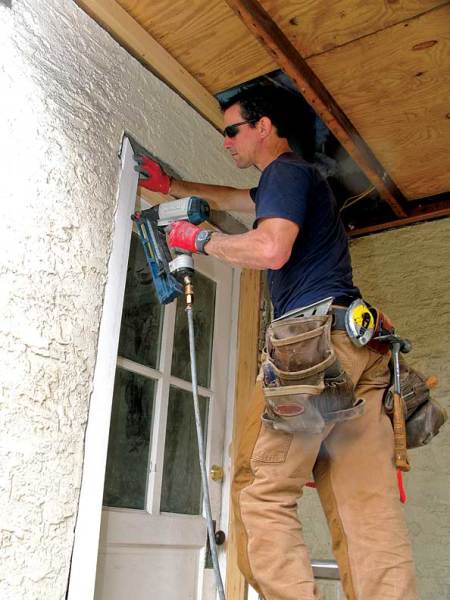Whether you’re a professional carpenter or a weekend DIYer, you can’t get by without a good tool belt, one that affords fast, efficient access to your stuff. No matter what you call it (bag, rig, belt, or pouch), one that suits you and your tools makes a big difference.

What to Look For
I have three main criteria for tool pouches: 1) I can walk and work easily, 2) I can access everything with a no-look grab, and 3) I can drop everything in, and snatch everything out, without having to wiggle or force it. For that reason, I like leather bags and belts. Even after they’re broken in, the pockets remain rigid enough to stay open, yet supple enough to let a hand pass in either direction. While padded belts can seem nice, they’re often too thick to hook a tool on. More and more tools have belt hooks on them, which is a feature I use often.
Tool belts are configured as either aprons or side bags. I prefer side bags, because they allow more mobility for climbing ladders, moving through joists, or bending to make cuts. I’ve often had an apron belt’s contents appear on my lap when crouching down to work on something. Side bags come in various configurations; some are complete sets, others individual components. For me, individual components work best, offering an unbeatable level of customization. My rig consists of two four-tiered side bags, one hammer loop, and a 2″ leather belt.
How to Use It
While there are lots of three-pouch bags available, four-tiered bags have a game-changing feature—a slot for my square. Storage is seamless, and the no-look grab’s a snap. I wear the same four-tiered bag on both hips, with different things in them.
Just below the square slot on the left is a soft-sided pouch for my tape measure. On the right, the pocket houses three hand tools: dikes, a screwdriver, and a 5-in-1 tool. The third pocket is the largest, and I use it on both sides for general storage. It carries anything from racks of gun nails to caulk, a chalk reel, molding returns, even a notebook. The fourth pocket, the lowest on my belt, gets lots of use. As a carpenter, I drive a lot of screws, and this is where I store them. I also carry pencils, driver bits, a counter-sink, nail set, chisel, scratch awl, and utility knife. My side bags have abundant slots and sleeves to house these tools vertically, in their own space.
There are two leather hammer loops on each of my side bags, but I don’t regularly use them for this purpose, because when I walk, the hammer hits my leg. Instead, I use them to hold tin snips for roofing or aluminum flashing. My hammer, meanwhile, swings in a rigid loop at the small of my back, where it’s out of the way yet easy to reach.
The Bottom Line
I’ve worked with many DIYers, and most have an annoying habit: Despite having a tool belt, they don’t use it. Instead, they leave the tape measure on the windowsill, then can’t find it when it’s time to measure the next piece. Or they mark something and put the pencil on the floor, only to find themselves later up on a ladder in need of a pencil. Sound familiar? No matter how awesome your tool belt, if you don’t use it, it does you no good.
Carpenter Mark Clement is working on his century-old American Foursquare in Ambler, Pennsylvania, and is the author of The Carpenter’s Notebook.







